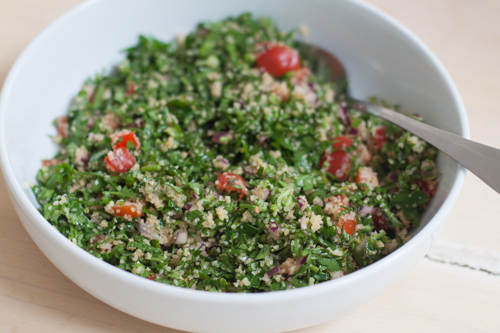Middle Eastern mezze no.4: Tabbouli
 Tuesday, April 12, 2011 at 9:26PM
Tuesday, April 12, 2011 at 9:26PM 
I read the Saturday Guardian magazine religiously, my favourite sections naturally being those on food and drink. I was very pleased one Saturday morning a few years back to find that Yotam Ottolenghi had dedicated his column to this favourite salad of mine. The subheader had its desired affect, drawing me in with the following statement:
There's a right way and a wrong way to make this brilliant Middle Eastern salad, says Yotam Ottolenghi. Here's the right way...
Had I been making it the right way all these years? A perfectionist through and through, I was very pleased to find that I had.
The most common issue is the proportions – far too many cooks do not realise that parsley is the star of the show here, not the bulgar … Another biggie is the way the herbs are chopped, and in this instance I'm afraid I must side with the purists and shun the food processor. Chopping the leaves with a razor-sharp, heavy knife, although a lot of work, prevents bruising and gives the parsley its light and dry texture.
“Tell me something I don’t know,” my Australian readership is probably thinking.
In Australia, well in the big cities at least, every kebab shop has tabbouli as one of the standard salad options. The quality varies, of course, but the herbs always take centre stage. I had never seen the bastardised version - bulgar wheat flecked with a few specks of green - until I moved to the UK in 2007; I didn’t even recognise it. As for using a food processor, this would never have crossed my mind, but I can see how it would be tempting for the less enthusiastic cook; tabbouli is certainly a labour of love.
My recipe, as it turns out, is almost exactly the same as Ottolenghi’s, except that I have always used red onion, rather than shallots, and I have never added all spice. Ottolenghi's method also includes a detailed explanation of the best way to chop the herbs to avoid bruising. I haven't provided this, so it is worthwhile looking at his recipe if you are unsure.
In my opinion, a Middle Eastern mezze selection would be incomplete without this refreshingly herbaceous and citrusy salad. Sometimes I might choose falafel over spicy lamb mince, say, or hummous instead of tzatziki, but I always, without fail, make a tabbouli.
This recipe serves four as a side salad or six to eight as part of a main mezze selection.

Ingredients
50g bulgar wheat
100ml boiling water
1 small bunch mint, finely chopped (approximately 25g)
1 large bunch flat leaf parsley, finely chopped (approximately 75g)
2 tomatoes, finely diced
1 small red onion, finely diced
Juice 1 lemon (approximately 50ml)
50 ml olive oil
Salt and freshly ground black pepper, to taste
Method
Rinse the bulgar wheat under cold water and put in a bowl, cover with the boiling water and leave to one side while you prepare the other ingredients.
Mix the mint, parsley, tomatoes, red onion, lemon juice, and olive oil in a large bowl and stir to combine.
When the bulgar wheat has soaked up all the water and cooled down, add to the rest of the ingredients and stir to combine.
Season with salt and pepper and adjust the level of lemon juice or olive oil as necessary.

 Vix |
Vix |  4 Comments |
4 Comments | 
Reader Comments (4)
Can't believe I was a day too late for this recipe! I made my version of this last night with my falafel and it's a good thing to see that my recipe is pretty much the same. The only thing I do differently is soak the bulgar with lemon juice rather than water
Hi Ray, lemon juice - that is a good idea. I think the reason I used boiling water is that I must have had some of the less fine variety in the past and found that it was a bit chewy if I used cold water or lemon juice. I noticed that Ottolenghi just soaks his in the lemon juice with the tomatoes as well and specifies fine bulgar wheat. I was thinking when I wrote the post that next time I make it I will test this method and, if I find it works, I will change the recipe. I just didn't want to change it without having tested it myself. Thanks for giving me more confidence with this.
I do use the fine bulgar wheat as well so that's probably why it works
Perfect, I will try it out next time.